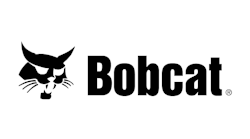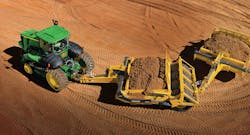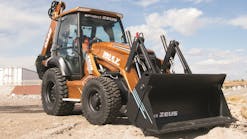Kansas farmer James Cummings and draftsman J. Earl McLeod designed the first bulldozer in 1923. When they filed for a US patent, they described it as an “attachment for tractors” used to plow fields. Large, powerful, and on tracks that gave it mobility through rugged terrain and grip in muddy conditions, its versatility led to widespread use in road building, construction, mining, forestry, land clearing, and projects requiring powerful and stable earth-moving equipment.
As the bulldozer approaches its 100th birthday, it has undergone changes that make it an even more versatile tool. Today’s dozers are used not only for earthmoving, but also for a variety of tasks that weren’t considered just a few years ago.
“The applications for dozers are as plentiful as your imagination,” says Sam Meeker, product application specialist for Caterpillar. “These machines are so much more capable than before, it’s amazing the work they can do. In addition to site preparation-type of work, dozers can stockpile materials, clear and clean up debris, pull out stuck vehicles, support other machines on the job site, and so much more.” Tractors configured with pipelayer attachments, or side-booms, are vital tools to help improve the energy infrastructure of many countries, including the United States and Canada.
Dozers are used to perform a wide variety of jobs, confirms Nathan Horstman, product marketing manager, crawler dozers, John Deere Construction & Forestry. Those jobs include site prep, road work, slope work, spreading material, ripping, land clearing, and finish work.
In addition, John Deere Dozers can be equipped with options like grade control, rippers, winches, and custom blade configurations from their factory in Dubuque, IA. “This versatility enables our customers to experience more productive solutions for any job type,” he says.
Komatsu PLUS Undercarriage track version
In the most traditional sense, bulldozers are designed to push large amounts of earth, but John Bauer, brand marketing manager, CASE Construction Equipment, says there are some configurations and attachments that provide added capabilities.
One of the most common is the single or multishank ripper. “This allows a dozer operator to loosen hard pack ground [and] rock to make it easier for either the dozer to push the material, or for excavators to more easily dig in an area,” he says.
Think of the whole process of building a site: land clearing, brush removal, stockpiling, and even processing the debris, Meeker visualizes. Next, move the earth and rough-grade the site. Dozers then spread the aggregate or fill material, and, finally, trim and finish-grade to final surveyed design. Using a dozer to do the fine finishing work of a motor grader saves money.
In addition to dozing and earthmoving Meeker adds, these machines spread materials, and can rough- and finish-grade. “Properly equipped, dozers can be used in land clearing, stockpiling, log skidding, waste handling, coal stockpile, agriculture, woodchip handling, winching, and many other applications.”
Dozers push dirt, but they also push other materials such as coal, wood chips, iron ore pellets offloaded from ships at port, and demolition and construction debris, emphasizes Charles Murawski, product manager, bulldozers, Komatsu.
Harkening back to their origins, dozers are still used extensively in the preparation of new tracts of agricultural land, where root rakes are added to the front of the machine to more easily separate roots and organic material from the soil that is being prepared for farmland.
In addition, dozers can be outfitted with tow hooks for pulling other machines or vehicles out of sticky situations. Similarly, they are used regularly in large land-clearing operations to push scrapers that might be bogged down in a certain area.
“While still technically ‘pushing dirt,'” says Bauer, “bulldozers are also used in truck-loading applications—often in overburden removal operations—where they push materials to wheel loaders or excavators that then load the material [onto] trucks.”
Dozers can also be used in wildfire mitigation to create fire breaks that can help slow down the advancement of a fire by creating separation between areas that might burn.
As Meeker observes, dozers range from being the only tool on the job, to supporting excavators, trucks, and wheel loaders as part of a team.
A Komatsu D155AX-8 with PLUS undercarriage stockpiles fracking sand
It’s Not Unusual…Or Is It?
“In my role of supporting dealers and customers, I’ve run into quite a few unusual applications,” recalls Meeker. “Customers use dozers in beach reclamation activities, where the machine is partially submerged for part of the dozing cycle. As one customer put it, ‘Reverse into the ocean until the water touches the cab platform, then doze back to shore!'”
Komatsu has also sold dozers for beach erosion work. “Storms remove sand,” says Komatsu’s Murawski. The rotating bushing undercarriage produces far less wear in this type of abrasive situation. “It provides up to two times the life and reduces downtime because there is no need for a pin and bushing turn. That saves money.”
Dozers are also adept in wooded areas. “Customers use V plows with a serrated edge for land clearing,” he continues. “The saw tooth cuts trees at the base and the ripper on the back gets the roots.” A disc harrow further back creates a windrow for the next planting in forestry and agricultural applications. The dozer does all this in a single pass, which saves money and time.
Komatsu D85EX-18 with PLUS undercarriage used for beach restoration in Florida
They can be used for soil conditioning, Murawski adds. “You mix water in the soil, and then rip the soil to mix it for consistency and stability.” He says this is done during commercial and residential site development in Texas, but because the ripper penetrates frost, it can also be useful to loosen frozen ground in northern states and Canada.
Instead of excavating a trench to lay cable, a smaller dozer (100–130 hp) can be used to cut a narrow trench. A spool of fiber optic cable is put on the front, routed to the back to the cable layer. “You can bury miles of cable without excavating,” observes Murawski.
Pulling cable plows and ag drainage tile plows are some other unusual configurations Meeker has seen. “Stringing power lines is an unusual application as well, with the dozer specially outfitted with two or three rear winches at a time,” he says.
Features, Attachments, and Versatility
Dozer configuration plays an important role in adding versatility on the job site. “Customers choose SU blades for higher capacity dozing and earthmoving, or VPAT blades for more versatility in finishing and grading,” says Meeker.
Several gauge options—from XL, to XW, to LGP—tailor the machine for the local soils and ground conditions, allowing them to work in softer conditions. “With the new design of VPAT blades, many customers are using this option in heavier and heavier work, expanding the portfolio of jobs they can bid on, and therefore, the versatility of the machine.”
John Deere 750K SmartGrade
Power, angle, tilt (PAT) blades increase the versatility of the dozer with increased blade maneuverability, explains Horstman. They can be used in a wide range of applications and are especially popular for fine grading.
“Hydrostatic drive and grade control is a key combination to increasing versatility in any size dozer,” he continues. This combination supports high productivity in all applications from rough dozing to fine grading because the hydrostatic drive gives the operator control over the dozer with the ability to fine-tune the speed. Grade control provides the experienced operator the ability to hold consistent grade throughout the day and allows a novice operator to become productive faster.
Integrated machine control adds functionality, according to Murawski. “Contractors use a motor grader for finish grading, but with GPS machine control for blade position, a dozer is capable of accurate, consistent results with less fatigue and more productivity. It adds versatility and capability.”
Technology has been a game changer in the dozer world. “Machine control technology has vastly improved the versatility of dozers by making them much more efficient and accurate in completing finished grades,” says CASE’s Bauer. “All bulldozers today are compatible with some level of integrated, installed, or aftermarket machine control technology [that] is going to drastically lower the amount of time required to complete finished grade and the amount of wear and tear put on a machine to complete a job.”
Features on Cat dozers such as Stable Blade help new operators create smooth surfaces with less training, Meeker says. Slope Indicate helps operators reach a desired slope and is a training tool to help them understand what a 5% slope looks and feels like.
“Cat Grade with Slope Assist has been a real game changer with our customers,” he explains. “They can grade and finish to a target slope more quickly and accurately, all without external GPS or laser attachments.”
There are limitations, he admits, but he says Cat customers are finding ways to use Slope Assist to improve their productivity and lower their costs with an exclusive feature, standard on many Cat dozers. AccuGrade Ready Option allows customer to easily and quickly install grade control systems that are tailored to the work they are performing—from laser, to GPS, to Universal Total Station systems.
“This provides great versatility, as a contractor can use the best system for the job, not being handcuffed to one particular solution,” says Meeker.
Another productivity boost comes from Cat Grade with 3D. “The versatility of the 3D [three-dimensional] system is a great benefit to customers in many ways,” he continues.
Customers can choose from a variety of GPS correction sources, from local base stations, to internet-based correction systems, to locally managed correction networks—even combining multiple systems tailored to specific job sites. “Cat Grade with 3D not only works with GPS, but also allows Slope Assist to be seamlessly used when you get to that shady spot on the job where satellite visibility is limited,” he says. “If your job requires higher precision, or is indoors, the AccuGrade Ready Option included with the 3D system allows an alternate system, such as laser or UTS, to be easily installed.”
Blades push more than just dirt. Modify a blade with a trash rack or attach a third-party blade for wood chips, Murawski advises.
The bulldozer’s primary tools are the blade and the ripper, but they aren’t the only ones. Other machines may have a wider variety of attachments from which to choose, but the tools available to the dozer add to its versatility. Rear attachments such as drawbars, rippers, or winches can be swapped out to equip the machine for specific jobs. Hydraulic winch to pull logs is useful in logging applications or for land clearing.
“Dozers can be configured to be used in unique applications like waste management, wildfire suppression, and pipe laying,” says Horstman. “John Deere can provide attachment solutions to meet the needs of customers using dozers in these and other special applications.”
Size Matters
Meeting the needs of customers can require various sizes of dozers to complete the work on different job sites. Murawski indicates that bigger dozers in the range of 200–600 hp are typically used in landfill, wood chip, and coal stockpile applications, while the 100-hp machines are sufficient for logging operations. The Komatsu product manager agrees that if the housing marketing is booming, sales increase for smaller dozers, but if the energy market is booming, sales increase for large dozers.
“While large dozers, D7 size and above, are primarily used for heavy dozing and earthmoving, the medium size dozers in the D6 range provide the versatility of smaller dozers and capacity as well,” says Meeker. “These machines can be equipped to fit the job, with options for blades, gauge, guarding, air handling, and many others to tailor the machine to the job.”
The size of a dozer greatly impacts versatility in a couple of ways, Bauer believes. “Naturally, a smaller dozer will be able to get in places that a larger dozer can’t, but you will sacrifice some power and performance. It’s also critical for contractors to know the transportation rules and regulations in the area they want to work. Your instincts may tell you to buy the biggest dozer you can for power and strength, but that power and strength is no good if you can’t legally transport that bulldozer across the region you want to work, due to weight restrictions. Larger dozers will ultimately give you more versatility as it relates to power; smaller dozers will let you get more places and not require as extensive of an investment as it relates to transportation.”
However, Horstman says that although most jobs required two sizes of dozers in the past—a big dozer for the large earthmoving work and a small dozer to do the finish work—today, thanks to the combination of hydrostatic drive and GPS, a big dozer can do all the heavy earthmoving and the fine work too. “PAT blades, with their extended blade range, have significantly improved the versatility of bigger dozers, especially for fine grading work,” he says. “The 850K SmartGrade Dozer can do precision grading as well handle the big dozing jobs.”
Dozers are strong, well-balanced, powerful machines with an excellent center of gravity, Bauer concludes. Operating on long steel tracks helps the machine stay on a consistent plane and be less affected by changes in terrain. The options in model type—from low ground pressure, to extra-long track or wide track—is another form of versatility, allowing contractors to pick the machine that will best suit their type and style of job site.
Versatility saves labor, shipping, equipment, and owner and operator costs.












